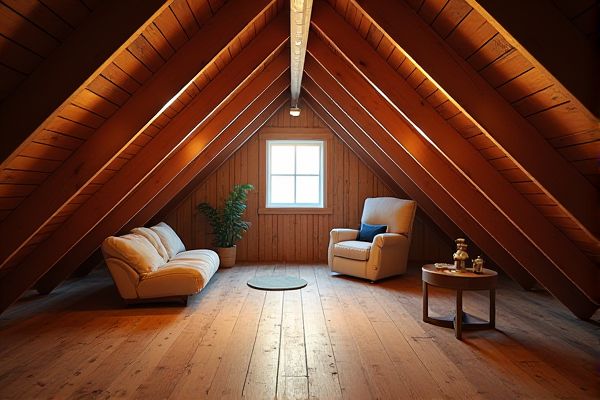
Attic LED lighting offers superior energy efficiency, longer lifespan, and better illumination quality compared to traditional fluorescent lighting, reducing your overall electricity costs and maintenance needs. Explore the rest of the article to understand how choosing the right lighting can transform your attic space.
Table of Comparison
| Feature | Attic LED Lighting | Fluorescent Lighting |
|---|---|---|
| Energy Efficiency | High (80-90% energy saving) | Moderate (40-60% energy saving) |
| Lifespan | 25,000 to 50,000 hours | 7,000 to 15,000 hours |
| Light Quality | Bright, consistent, no flicker | Moderate brightness, slight flicker |
| Heat Emission | Low heat output | Higher heat generation |
| Durability | Shock and vibration resistant | Fragile, contains glass tubes |
| Environmental Impact | Mercury-free, recyclable | Contains mercury, requires special disposal |
| Initial Cost | Higher upfront cost | Lower upfront cost |
| Maintenance | Low, long replacement cycle | Higher frequency of replacement |
| Instant On | Yes, immediate full brightness | No, slight warm-up time |
Introduction to Attic Lighting Solutions
Attic LED lighting offers energy-efficient, long-lasting illumination that significantly reduces electricity costs compared to traditional fluorescent lighting. Fluorescent bulbs emit a cooler, harsher light and often require more frequent replacements due to shorter lifespans and sensitivity to temperature fluctuations. Your choice of attic lighting can enhance visibility and safety while optimizing energy consumption with LED solutions being the superior option.
Overview of LED and Fluorescent Lighting Technologies
LED lighting utilizes semiconductor diodes that emit light when an electric current passes through, offering high energy efficiency and long lifespan compared to traditional lighting. Fluorescent lighting relies on gas-discharge tubes filled with mercury vapor that produce ultraviolet light converted to visible light by a phosphor coating, often providing cool, diffused illumination with moderate energy consumption. In attic spaces, LED lighting delivers superior brightness, instant startup, and reduced heat output, while fluorescent lights may have longer warm-up times and contain hazardous materials requiring careful disposal.
Energy Efficiency: LED vs Fluorescent in Attics
LED attic lighting consumes up to 80% less energy than fluorescent lighting, significantly reducing electricity costs. LEDs have a longer lifespan, often exceeding 25,000 hours, compared to fluorescents that typically last around 10,000 hours, decreasing replacement frequency and maintenance expenses. The higher lumens-per-watt ratio of LEDs enhances brightness efficiency, making them the superior choice for energy-conscious attic illumination.
Brightness and Light Quality Comparison
Attic LED lighting provides higher brightness levels with lumen outputs ranging from 800 to 1600 per bulb, surpassing traditional fluorescent lights which average around 600 to 1000 lumens. LEDs offer superior light quality with a color rendering index (CRI) of 80-90, producing more natural and vibrant illumination compared to fluorescent lights with a CRI typically between 50-70. The consistent, flicker-free illumination of LEDs enhances visibility and reduces eye strain in attic spaces, making them a more effective lighting choice.
Longevity and Maintenance Requirements
Attic LED lighting offers significantly longer lifespan than fluorescent lighting, often lasting up to 25,000 to 50,000 hours compared to 7,000 to 15,000 hours for fluorescents. LED fixtures require minimal maintenance due to durable construction and fewer component failures, while fluorescent bulbs need frequent replacements and careful handling due to fragile tubes and mercury content. Choosing LED lighting for your attic reduces maintenance efforts and replacement costs over time, making it a more efficient and cost-effective solution.
Installation Considerations for Attic Spaces
Attic LED lighting typically requires minimal wiring adjustments and can be installed in tight or irregular spaces due to its compact design and flexibility, making it ideal for difficult attic layouts. Fluorescent lighting installation often demands more space for ballast and tube fixtures, along with careful handling and disposal due to mercury content. Your attic project will benefit from LED's ease of installation, longer lifespan, and reduced maintenance compared to fluorescent options.
Cost Analysis: Initial and Long-Term Expenses
Attic LED lighting incurs higher initial costs compared to fluorescent lighting but offers significantly lower long-term expenses due to energy efficiency and longer lifespan, reducing replacement and maintenance frequency. Fluorescent lights cost less upfront but consume more electricity and require frequent bulb replacements, increasing operational expenses over time. Investing in LED technology results in substantial savings on energy bills and maintenance over the lifespan of attic lighting installations.
Safety and Environmental Impact
Attic LED lighting offers superior safety by generating significantly less heat compared to fluorescent lighting, reducing fire risks in confined spaces. LEDs contain no hazardous materials like mercury, which is present in fluorescent bulbs and poses environmental contamination hazards during disposal. Energy-efficient LED lights also lower carbon emissions by consuming less electricity, contributing to a smaller ecological footprint relative to fluorescent alternatives.
Smart Features and Compatibility
Attic LED lighting offers advanced smart features such as dimming capabilities, motion sensors, and compatibility with home automation systems, providing greater energy efficiency and convenience compared to fluorescent lighting. Fluorescent lights typically lack seamless integration with smart home devices and often require additional adapters or controllers. Your attic lighting system benefits from LED technology through enhanced compatibility with voice assistants and programmable settings, ensuring optimal performance and user control.
Final Recommendations for Attic Lighting Choices
LED attic lighting offers superior energy efficiency, longer lifespan, and better durability compared to fluorescent lighting, reducing maintenance and operational costs. Fluorescent lights can produce adequate brightness but often contain mercury, posing environmental hazards and requiring careful disposal. For optimal attic illumination, LED lighting provides enhanced brightness, quicker startup, and improved safety, making it the preferred choice for most attic applications.
 homyna.com
homyna.com